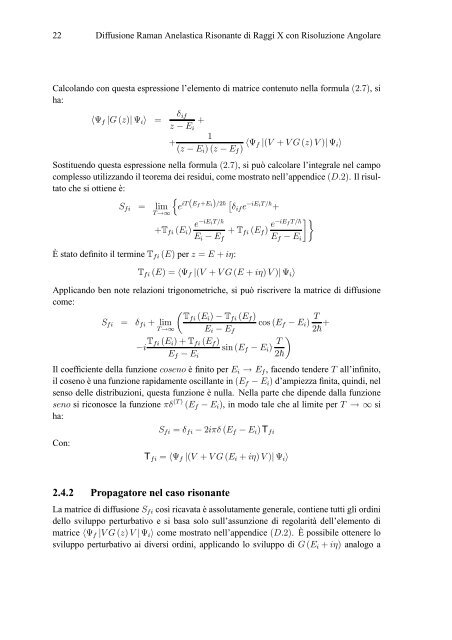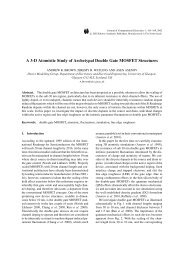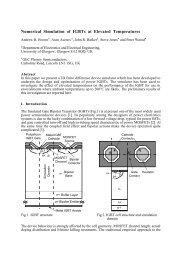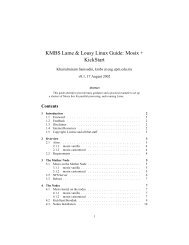Diffusione Raman Anelastica Risonante di Raggi X con Risoluzione ...
Diffusione Raman Anelastica Risonante di Raggi X con Risoluzione ...
Diffusione Raman Anelastica Risonante di Raggi X con Risoluzione ...
Create successful ePaper yourself
Turn your PDF publications into a flip-book with our unique Google optimized e-Paper software.
22 <strong>Diffusione</strong> <strong>Raman</strong> <strong>Anelastica</strong> <strong>Risonante</strong> <strong>di</strong> <strong>Raggi</strong> X <strong>con</strong> <strong>Risoluzione</strong> Angolare<br />
Calcolando <strong>con</strong> questa espressione l’elemento <strong>di</strong> matrice <strong>con</strong>tenuto nella formula (2.7), si<br />
ha:<br />
δif<br />
hΨf |G (z)| Ψii = +<br />
z − Ei<br />
1<br />
+<br />
(z − Ei)(z − Ef) hΨf |(V + VG(z) V )| Ψii<br />
Sostituendo questa espressione nella formula (2.7), si può calcolare l’integrale nel campo<br />
complesso utilizzando il teorema dei residui, come mostrato nell’appen<strong>di</strong>ce (D.2). Il risultato<br />
che si ottiene è:<br />
Sfi =<br />
n<br />
lim e<br />
T →∞<br />
iT(Ef +Ei)/2~ £ δife−iEiT/~ +<br />
+Tfi (Ei) e−iEiT/~<br />
Ei − Ef<br />
+ Tfi (Ef) e−iEf T/~<br />
Ef − Ei<br />
È stato definito il termine Tfi(E) per z = E + iη:<br />
Tfi (E) =hΨf |(V + VG(E + iη) V )| Ψii<br />
Applicando ben note relazioni trigonometriche, si può riscrivere la matrice <strong>di</strong> <strong>di</strong>ffusione<br />
come:<br />
µ<br />
Tfi(Ei) − Tfi (Ef)<br />
Sfi = δfi +lim<br />
T →∞ Ei − Ef<br />
−i Tfi (Ei)+Tfi (Ef)<br />
Ef − Ei<br />
¸¾<br />
cos (Ef − Ei) T<br />
2~ +<br />
sin (Ef − Ei) T<br />
<br />
2~<br />
Il coefficiente della funzione coseno è finito per Ei → Ef, facendo tendere T all’infinito,<br />
il coseno è una funzione rapidamente oscillante in (Ef − Ei) d’ampiezza finita, quin<strong>di</strong>, nel<br />
senso delle <strong>di</strong>stribuzioni, questa funzione è nulla. Nella parte che <strong>di</strong>pende dalla funzione<br />
seno si ri<strong>con</strong>osce la funzione πδ (T ) (Ef − Ei), in modo tale che al limite per T →∞si<br />
ha:<br />
Con:<br />
Sfi = δfi − 2iπδ (Ef − Ei) Tfi<br />
Tfi = hΨf |(V + VG(Ei + iη) V )| Ψii<br />
2.4.2 Propagatore nel caso risonante<br />
La matrice <strong>di</strong> <strong>di</strong>ffusione Sfi così ricavata è assolutamente generale, <strong>con</strong>tiene tutti gli or<strong>di</strong>ni<br />
dello sviluppo perturbativo e si basa solo sull’assunzione <strong>di</strong> regolarità dell’elemento <strong>di</strong><br />
matrice hΨf |VG(z) V | Ψii come mostrato nell’appen<strong>di</strong>ce (D.2). È possibile ottenere lo<br />
sviluppo perturbativo ai <strong>di</strong>versi or<strong>di</strong>ni, applicando lo sviluppo <strong>di</strong> G (Ei + iη) analogo a





